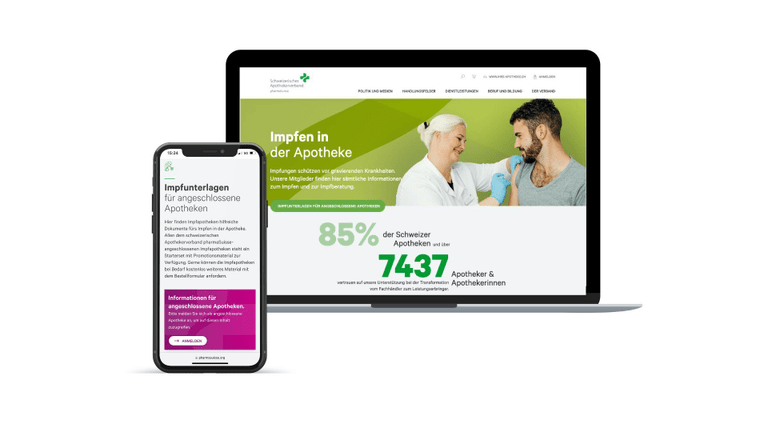As a product owner assistant at Liip, I enable customers to get the most out of the products we build together. In this article, I want to reflect on the learnings I made during the relaunch of pharmaSuisse - the new platform of the Swiss Pharmacists Association.
Goodbye individual CMS, hello open-source CMS. The new websites of the Swiss Pharmacists Association are based on the open-source solution Drupal, including a decoupled frontend with Nuxt, an ERP integration, user account management, different commerce workflows, and a paywall that gives members exclusive access to content.
Running Multiple Products on One Platform
Together with pharmaSuisse, we chose to develop a platform that could feed multiple web presences:
- pharmasuisse.org is the place where all members (pharmacies and pharmacists) get access to relevant information for them, can buy products or change their data
- ihre-apotheke.ch is the place where the general public can find the pharmacy that best suits their needs
- fphch.org serves as an entry point for the education of pharmacists
All three sites benefit from the same base functionalities:
- A modern design system that can be slightly adapted to each website's needs
- Flexible content blocks & editing capabilities based on our Interactive Page Builder blökkli
- Two-way synchronisation with the Navision ERP system thanks to the Odata API Sync module
- Granular, role-based access controls that allow to serve premium content to association members behind a paywall
- Integrated shop system that serves 4 different product types such as physical products, e-learnings, digital downloads and licence keys with Drupal Commerce
- Powerful automated translation workflows thanks to the Translation Management Tool ecosystem
- A form builder that allows editors to create online forms using webforms
Working with multiple Product Owners on one platform was an inspiration for me. For the planning, this means that we dedicate certain sprints to the particular needs of a platform. At times it was a challenge to consolidate the needs onto a unified platform, but for me, the advantages were evident in this case. Each increment didn’t only add to one of the site instances but would automatically benefit the others. The focus per sprint on a product helped the rhythm of the implementation and gave pauses and time for each Product Owner to prepare for their next turn.
Staging the Go-Live
We decided to go live with the smallest platform first. This gave us the opportunity to incorporate a good amount of learnings for the more challenging go-lives that came after that. If possible, I recommend going live with a smaller version of the product before doing a big bang launch where the risks of failure can be very high.
Adapting the Pace
The relaunch of this platform involved touching various integration points. A complex ERP integration and further interfaces needed to be implemented. Over the course of the project, we realised that the pace of delivery was not aligned and too fast in comparison to the pace of the other organisations involved. What helped us was taking breaks and using this time to get stories tested and resolve dependencies between systems. Since this experience, I try to implement sprint breaks after 2-4 sprints so that the affected people have time to use the system, incorporate the learnings, and revisit design or conceptual questions before we continue with further implementation cycles.
Creating Feedback Loops and Transparency
With every complex project, the situation can change drastically over time. You get more insight into what is to be done, you identify shortcuts or other obstacles, and new ideas emerge. Using agile methods, we kept everyone up-to-date by delivering working software from day 1. We were able to update the forecast of how much work is left for the MVP to be finished. We could add new feature requests and drop one that we prioritised lower. Often these come with a trade-off, and especially if you relaunch a grown existing system, people are worried about all the important things they are used to and will lose. By maintaining transparency about what is possible in terms of time and budget, we navigated the scope discussions with the Product Owners and delivered the new platform within 10 months.
I would like to thank the three pharmaSuisse Product Owners, Simona Kröni, Jens Apel, Cristian Dias and the entire pharmaSuisse team, for your dedicated work in realising this web relaunch together with Liip.

